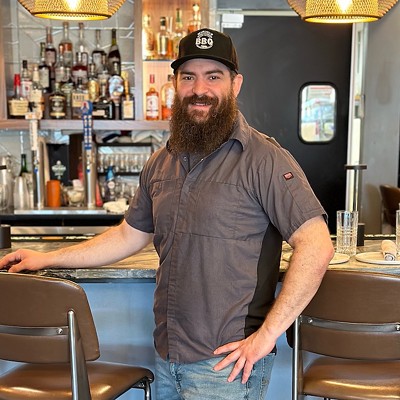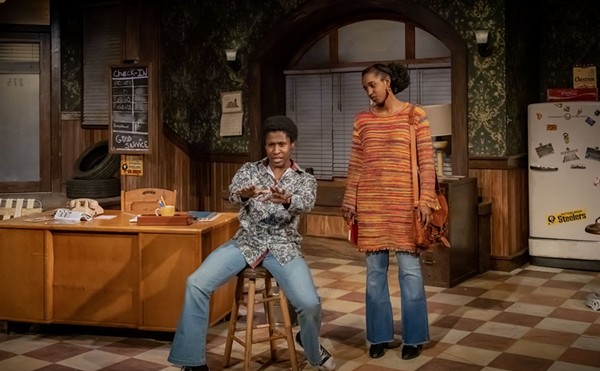The Birth of Genius -- Unique among the many displays nationwide celebrating the 100th birthday of legendary designer Viktor Schreckengost, this exhibition unveils rare sketches and design concepts from 1924 to '29, when Schreckengost was a student at the Cleveland Institute of Art (where he would eventually become the youngest faculty member in school history). In lieu of later masterpieces, the show features early school projects masterfully executed across a staggeringly diverse range. Whether sketching the human figure, designing a lamp, or conceiving a mural, Schreckengost excelled in every artistic attempt, lofty or mundane. He accomplished his task with unwavering finesse, understanding, balance, and attention to detail. A highlight among the figural sketches is "Nude Seated Female": Straight lines are nowhere to be found on this drawing of a seated woman -- only dynamic curves that set her in palpable motion. Perhaps the strongest harbinger of Schreckengost's design career is "Decorative Figure in Porcelain." Form and function unite stunningly in this design for an Art Deco statuette, its arched arm and flowing hair merging into a column that completes and supports the figurine. Of course, even the best of us has a bad day occasionally. Schreckengost's came during his sophomore year, when he sketched a male figure and apparently tried later to change its sex, adding breasts and bobbed hair with little success. But it's still a Schreckengost, and even this awkward piece has undeniable flair. Through August 18 at the Cleveland Institute of Art, 11141 East Blvd., 216-421-7403, www.cia.edu. -- Zachary Lewis
Florescence -- Emerging from a realist period, local painter Dana Oldfather fills her first solo exhibition in Cleveland with new "existential studies" exploring the complex and intrinsically contradictory nature of womankind. Her subjects, painted on board in flat, solid colors, are almost all variations on today's ideal of beauty: tall, thin, blonde or brunette, and stylishly dressed in low-slung pants and tight-fitting shirts. But the similarities end there. Each image represents a unique and intriguing blend of opposites. Physically, the women's skin looks soft, while their features and bony frames are angular and harsh. Their attitudes are even more enigmatic: They evade connection with their surroundings with averted eyes and disengaged postures, but it's hard to tell whether they're absorbed in thought or simply self-absorbed; either way, they are islands of calm. In "The Four," we see four women, their backs to one another, working in a kitchen either in icy silence or at a familial hum. Oldfather's subjects appear either caring or cruel, depending on the viewer's interpretation; the anguished man in "Carolyn Reclining" may be receiving close, thoughtful attention from his blond companion on the couch, but more likely he's being tuned out. The most touching scene here, "Cotton and Breathing," is a solo portrait. An orange-haired woman of exceptionally delicate frame pauses on the street, her hand on her chest. Maybe she's just catching her breath. Or maybe this proud but fragile creature is overwhelmed with a feeling we can only imagine. Through June 24 at E Gordon Gallery, 2026 Murray Hill Rd., 216-795-0971, www.egordongallery.com. -- Lewis
ONGOING
Afrofuturism -- How might technology affect race relations and African American culture? It's an enormous loaded question, but Afrofuturism is thorough and imaginative in its answer. Seventeen artists address the issue in a large and diverse multimedia exhibition from the Obsidian Gallery in Minneapolis. If there's a unifying theme, it's that racial advancement won't be unidirectional; rather, it'll zigzag and reverse, always looking backward even as it moves forward. "Black to the Afro-Future: A Road Map," by Oakland artist Amanda Williams, simultaneously embodies and critiques this theme. Straight red lines of paint and string veer over a black wall like a treasure map, their circuitous paths intersecting at Altoid tins painted to depict stages of black history. Strategically placed text at widely separated points mark "where we want to be" and "where we're supposed to be," suggesting that in reality, racial utopia may be impossible to achieve. But not everything here is so serious: Seitu Jones of Minneapolis injects a satisfying dose of satirical humor with "Noirex," a fake magazine advertisement for a pill that "corrects excessive melanin" -- i.e., turns black skin white. Enjoy the funny before-and-after photos, but also note the fine print that details the staggering side effects, which include "loss of rhythm." Through June 9 at Spaces Gallery, 2220 Superior Viaduct, 216-621-2314, www.spacesgallery.org. -- Lewis
Brush & Lens: The Feininger Family Legacy -- Late photography legend Andreas Feininger was born 100 years ago this year; his father, Lyonel, a comparably gifted printmaker and Bauhaus advocate, died 50 years ago. Contessa Gallery honors this 100/50 convergence with a stunning and rare opportunity to view their work side by side and observe the sense of shape and architecture they shared. Andreas, who spent two decades shooting black-and-white landscapes for Life magazine, had an affinity for the colossal urban setting and congestion of Manhattan, but he also documented the effects of industry and mass transit on smaller cities, towns, and remote expanses. Original autographed examples of each are represented here -- including his famous "Texaco Station on Rt. 66" -- and they're almost uniformly dazzling. At every turn, it's plain that Andreas possessed not only a profound eye for light and composition, but also vast reserves of patience and technical knowhow. "Navy Helicopter" seems furthest ahead of its time: Spinning chopper blades slice a balletic cyclone pattern of light in the dark sky in this impossibly long nighttime exposure of a helicopter landing. The geometric gene clearly came straight from Lyonel, whose black-and-white prints depicting sailboats and rooftop skylines are multilayered wonders of pure line and shape. The real fun lies in spotting common motifs: Lyonel's "Three Sailing Ships" is technically a seascape, but its nine vertical masts call to mind a row of skyscrapers or field of oil wells in one of Andreas' photos. "Like father, like son" is an understatement in their case. Through May 28 at Contessa Gallery, 24667 Cedar Road, Lyndhurst, 216-382-7800, www.contessagallery.com. -- Lewis
Electric Lemonade -- Nothing passes for dull at this tart, refreshing show of contemporary local art: Works goofy, garish, and gruesome clamor for attention, while more serious pieces transcend the clatter. Amber McElreath's paintings on large wooden boards fuse influences of stained glass and Cubism, fragmenting figural portraits into tiny shards of pastel greens, browns, and oranges. Though the works are untitled and superficially abstract, a keen eye can discern images such as a young person playing piano. Each piece artfully implies a complex, multifaceted identity -- one awaiting the viewer to discern. Elsewhere, Kate Tobin's prints employ a more raw tack: Her best work, "Soul Contamination, Soul Preservation," consists of numerous images of a baby in a gas mask, crawling through a barren landscape. Searing, unrealistically bright colors suggest a deadly environment, while the baby conveys a sense of fragility and utter dependence. In other words: Life is rough, and survivors rely on extreme measures. Adding sugar to the show are Steve Sorin's black-and-white photographs of Barbie dolls in dramatic situations. Riffing on romance and Barbie's body image, Sorin pairs her with a classically masculine Greek statue, setting them in ludicrously clichéd scenarios. In "Adios Ken," they huddle near a picturesque cemetery, Barbie's hair flowing passionately in the wind. Through May 27 at the Pop Shop, 17020 Madison Ave., Lakewood, 216-227-8440. -- Lewis
Seven -- Curator, painter, and local art maven Douglas Max Utter couldn't have picked a better venue for this seven-artist show exploring the seven deadly sins. The gothic solemnity of Convivium -- a former church -- amplifies the art's already strong call for personal reflection. Visually, however, Seven is a mixed bag, diminished on occasion by thin thematic connections. Among the most cohesive works are two "Avarice" installations by Clevelander Jess Wheelock: Both effectively illustrate the vanity of material possessions by depicting all matter's gradual return to dust. "Avarice #2" is a set of fancy dinner plates thickly encrusted with dirt, like unearthed relics, some still revealing patches of ornamental gold leaf. "Avarice #1" is a mound of soil nearly burying a bunch of one-time treasures: radio, answering machine, telephone. But five miniature chairs situated around the pile take the piece one step further, suggesting evidence of a ceremony -- a deliberate, bonfire-like destruction of worldly goods. Cecilia Phillips indirectly exposes the horrors of "Gluttony" with comparable potency in a painting of a lamb's head on a platter with garnish. Besides alluding to the gruesome fate of St. John the Baptist, the detailed, lustrously shaded image also evokes those ugly 19th-century still lifes of freshly caught rabbits and fish. Only this lamb isn't bloody: Complete with fur, eyes, and ears, it's almost alive, not to mention utterly unappetizing. Through May 28 at Convivium 33 Gallery, 1433 East 33rd St., 216-881-7828, www.josaphatartshall.com. -- Lewis
Smooth/Striated -- Technically, it wouldn't be impossible to wear these tiny, finely crafted works of art by Northeast Ohioans Sofia Calderwood and Susan Skoczen as actual jewelry. But wearing them would complicate the task of paying these intricate marvels the close attention they deserve. Calderwood's nature-inspired bracelets and necklaces are less practical than Skoczen's essentially functional rings, but they're significantly more seductive. Setting aside her usual metal, Calderwood fills her imaginative molds instead with semi-transparent white plastic -- the "smooth" half of the title. In "White Frond," this luminescent substance takes the form of thin ropes tightly braided into a thick bracelet, a few purple-tipped strands fraying from the loop. It'd be a ticklish piece to wear -- one that seems alive with motion, like an anemone swaying in an imperceptibly light current beneath the sea. (Gallery M's display cases -- oblong glass boxes with sturdy metal frames, like 19th-century aquariums -- heighten this sense of being underwater.) Back on land, Calderwood again uses plastic for a necklace lined with white daisies. There's a compelling innocence about this: It's easy to imagine a little girl plucking flowers and stringing them together in much the same way. A block motif unites many of Skoczen's rings: Thin, exceptionally delicate tendrils of gold and silver support large, sometimes humorously top-heavy ornaments. Her imagination and craft are uniformly powerful, but it's the rare flash of color -- such as the three small patches of orange felt atop the mushroom-shaped "Nestling About" -- that distinguishes her most fetching pieces. Through June 2 at Gallery M, 1667 East 40th St. Suite 3-B, 216-773-8277. -- Lewis











